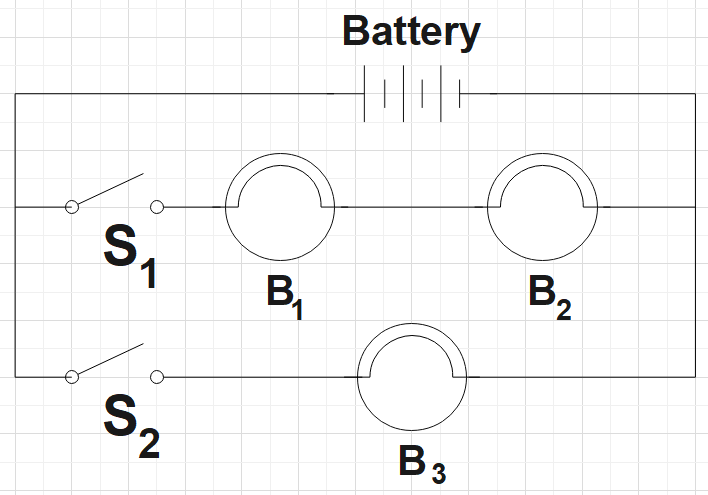
Draw a circuit diagram to show how 3bulbs can be lit from a battery so that 2 bulbs are controlled by the same switch while the third bulb has its own switch.
Answer
504.6k+ views
Hint: As a first step, one could read the question well and hence note down the two important conditions to be followed while drawing the circuit. Now one could recall how a battery and switch functions and hence apply these points and hence make the required circuit.
Complete step-by-step solution: -
In the question, we are asked to draw a circuit diagram with three bulbs and a battery. We are given two conditions. One being that all three bulbs are lit with a single battery given and the second condition is that two of the bulbs should be controlled by a single switch and the third bulb should have its own switch.
For the three bulbs to be controlled by a single battery we could simply connect the battery parallel to all the three bulbs thus satisfying the first condition.
Now for the second condition; we could connect one switch in series to two of the bulbs and another switch in series with the third bulb, thereby satisfying the third condition.
Hence, we get three branches one with the battery, second with two bulbs and a switch and finally we have the third branch with a bulb and a switch.
The required circuit is drawn below.

Note: The switch ${{S}_{1}}$is connected exclusively for the bulbs ${{B}_{1}}$and ${{B}_{2}}$. That is switching ON or OFF of this switch doesn’t affect the third bulb ${{B}_{3}}$as the bulb has its own switch ${{S}_{2}}$. The battery provides the same potential difference for every branch as the result of being connected parallel to them.
Complete step-by-step solution: -
In the question, we are asked to draw a circuit diagram with three bulbs and a battery. We are given two conditions. One being that all three bulbs are lit with a single battery given and the second condition is that two of the bulbs should be controlled by a single switch and the third bulb should have its own switch.
For the three bulbs to be controlled by a single battery we could simply connect the battery parallel to all the three bulbs thus satisfying the first condition.
Now for the second condition; we could connect one switch in series to two of the bulbs and another switch in series with the third bulb, thereby satisfying the third condition.
Hence, we get three branches one with the battery, second with two bulbs and a switch and finally we have the third branch with a bulb and a switch.
The required circuit is drawn below.

Note: The switch ${{S}_{1}}$is connected exclusively for the bulbs ${{B}_{1}}$and ${{B}_{2}}$. That is switching ON or OFF of this switch doesn’t affect the third bulb ${{B}_{3}}$as the bulb has its own switch ${{S}_{2}}$. The battery provides the same potential difference for every branch as the result of being connected parallel to them.
Recently Updated Pages
Master Class 12 Business Studies: Engaging Questions & Answers for Success

Master Class 12 Economics: Engaging Questions & Answers for Success

Master Class 12 English: Engaging Questions & Answers for Success

Master Class 12 Maths: Engaging Questions & Answers for Success

Master Class 12 Social Science: Engaging Questions & Answers for Success

Master Class 12 Chemistry: Engaging Questions & Answers for Success

Trending doubts
The pH of the pancreatic juice is A 64 B 86 C 120 D class 12 biology CBSE

Explain sex determination in humans with the help of class 12 biology CBSE

Draw ray diagrams each showing i myopic eye and ii class 12 physics CBSE

Which state in India is known as the Granary of India class 12 social science CBSE

Using Huygens wave theory derive Snells law of ref class 12 physics CBSE

Dihybrid cross is made between RRYY yellow round seed class 12 biology CBSE




